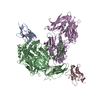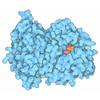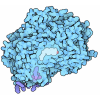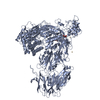[English] 日本語
 Yorodumi
Yorodumi- PDB-8cml: Cryo-EM structure of complement C5 in complex with nanobodies UNb... -
+ Open data
Open data
- Basic information
Basic information
| Entry | Database: PDB / ID: 8cml | |||||||||||||||
|---|---|---|---|---|---|---|---|---|---|---|---|---|---|---|---|---|
| Title | Cryo-EM structure of complement C5 in complex with nanobodies UNbC5-1 and UNbC5-2 | |||||||||||||||
 Components Components |
| |||||||||||||||
 Keywords Keywords | IMMUNE SYSTEM / nanobody / inhibitor / complement / C5 / inhibition / convertase / classical pathway / nanobody-antigen complex / alternative pathway | |||||||||||||||
| Function / homology |  Function and homology information Function and homology informationTerminal pathway of complement / membrane attack complex / Activation of C3 and C5 / negative regulation of macrophage chemotaxis / complement activation, alternative pathway / chemokine activity / endopeptidase inhibitor activity / positive regulation of vascular endothelial growth factor production / positive regulation of chemokine production / Peptide ligand-binding receptors ...Terminal pathway of complement / membrane attack complex / Activation of C3 and C5 / negative regulation of macrophage chemotaxis / complement activation, alternative pathway / chemokine activity / endopeptidase inhibitor activity / positive regulation of vascular endothelial growth factor production / positive regulation of chemokine production / Peptide ligand-binding receptors / complement activation, classical pathway / Regulation of Complement cascade / chemotaxis / G alpha (i) signalling events / killing of cells of another organism / cell surface receptor signaling pathway / inflammatory response / G protein-coupled receptor signaling pathway / signaling receptor binding / extracellular space / extracellular exosome / extracellular region Similarity search - Function | |||||||||||||||
| Biological species |   Homo sapiens (human) Homo sapiens (human) | |||||||||||||||
| Method | ELECTRON MICROSCOPY / single particle reconstruction / cryo EM / Resolution: 3.6 Å | |||||||||||||||
 Authors Authors | De la O Becerra, K.I. / Gros, P. | |||||||||||||||
| Funding support |  Netherlands, European Union, Netherlands, European Union,  Mexico, 4items Mexico, 4items
| |||||||||||||||
 Citation Citation |  Journal: J Biol Chem / Year: 2023 Journal: J Biol Chem / Year: 2023Title: Inhibition of cleavage of human complement component C5 and the R885H C5 variant by two distinct high affinity anti-C5 nanobodies. Authors: Eva M Struijf / Karla I De la O Becerra / Maartje Ruyken / Carla J C de Haas / Fleur van Oosterom / Danique Y Siere / Joanne E van Keulen / Dani A C Heesterbeek / Edward Dolk / Raimond ...Authors: Eva M Struijf / Karla I De la O Becerra / Maartje Ruyken / Carla J C de Haas / Fleur van Oosterom / Danique Y Siere / Joanne E van Keulen / Dani A C Heesterbeek / Edward Dolk / Raimond Heukers / Bart W Bardoel / Piet Gros / Suzan H M Rooijakkers /  Abstract: The human complement system plays a crucial role in immune defense. However, its erroneous activation contributes to many serious inflammatory diseases. Since most unwanted complement effector ...The human complement system plays a crucial role in immune defense. However, its erroneous activation contributes to many serious inflammatory diseases. Since most unwanted complement effector functions result from C5 cleavage into C5a and C5b, development of C5 inhibitors, such as clinically approved monoclonal antibody eculizumab, are of great interest. Here, we developed and characterized two anti-C5 nanobodies, UNbC5-1 and UNbC5-2. Using surface plasmon resonance, we determined a binding affinity of 119.9 pM for UNbC5-1 and 7.7 pM for UNbC5-2. Competition experiments determined that the two nanobodies recognize distinct epitopes on C5. Both nanobodies efficiently interfered with C5 cleavage in a human serum environment, as they prevented red blood cell lysis via membrane attack complexes (C5b-9) and the formation of chemoattractant C5a. The cryo-EM structure of UNbC5-1 and UNbC5-2 in complex with C5 (3.6 Å resolution) revealed that the binding interfaces of UNbC5-1 and UNbC5-2 overlap with known complement inhibitors eculizumab and RaCI3, respectively. UNbC5-1 binds to the MG7 domain of C5, facilitated by a hydrophobic core and polar interactions, and UNbC5-2 interacts with the C5d domain mostly by salt bridges and hydrogen bonds. Interestingly, UNbC5-1 potently binds and inhibits C5 R885H, a genetic variant of C5 that is not recognized by eculizumab. Altogether, we identified and characterized two different, high affinity nanobodies against human C5. Both nanobodies could serve as diagnostic and/or research tools to detect C5 or inhibit C5 cleavage. Furthermore, the residues targeted by UNbC5-1 hold important information for therapeutic inhibition of different polymorphic variants of C5. | |||||||||||||||
| History |
|
- Structure visualization
Structure visualization
| Structure viewer | Molecule:  Molmil Molmil Jmol/JSmol Jmol/JSmol |
|---|
- Downloads & links
Downloads & links
- Download
Download
| PDBx/mmCIF format |  8cml.cif.gz 8cml.cif.gz | 319.7 KB | Display |  PDBx/mmCIF format PDBx/mmCIF format |
|---|---|---|---|---|
| PDB format |  pdb8cml.ent.gz pdb8cml.ent.gz | 248.3 KB | Display |  PDB format PDB format |
| PDBx/mmJSON format |  8cml.json.gz 8cml.json.gz | Tree view |  PDBx/mmJSON format PDBx/mmJSON format | |
| Others |  Other downloads Other downloads |
-Validation report
| Summary document |  8cml_validation.pdf.gz 8cml_validation.pdf.gz | 1.3 MB | Display |  wwPDB validaton report wwPDB validaton report |
|---|---|---|---|---|
| Full document |  8cml_full_validation.pdf.gz 8cml_full_validation.pdf.gz | 1.4 MB | Display | |
| Data in XML |  8cml_validation.xml.gz 8cml_validation.xml.gz | 62.5 KB | Display | |
| Data in CIF |  8cml_validation.cif.gz 8cml_validation.cif.gz | 91.6 KB | Display | |
| Arichive directory |  https://data.pdbj.org/pub/pdb/validation_reports/cm/8cml https://data.pdbj.org/pub/pdb/validation_reports/cm/8cml ftp://data.pdbj.org/pub/pdb/validation_reports/cm/8cml ftp://data.pdbj.org/pub/pdb/validation_reports/cm/8cml | HTTPS FTP |
-Related structure data
| Related structure data |  16730MC M: map data used to model this data C: citing same article ( |
|---|---|
| Similar structure data | Similarity search - Function & homology  F&H Search F&H Search |
- Links
Links
- Assembly
Assembly
| Deposited unit | 
|
|---|---|
| 1 |
|
- Components
Components
| #1: Antibody | Mass: 16095.776 Da / Num. of mol.: 1 Source method: isolated from a genetically manipulated source Source: (gene. exp.)   |
|---|---|
| #2: Protein | Mass: 73361.453 Da / Num. of mol.: 1 / Source method: isolated from a natural source / Source: (natural)  Homo sapiens (human) / References: UniProt: P01031 Homo sapiens (human) / References: UniProt: P01031 |
| #3: Protein | Mass: 112635.008 Da / Num. of mol.: 1 / Source method: isolated from a natural source / Source: (natural)  Homo sapiens (human) / References: UniProt: P01031 Homo sapiens (human) / References: UniProt: P01031 |
| #4: Antibody | Mass: 16757.295 Da / Num. of mol.: 1 Source method: isolated from a genetically manipulated source Source: (gene. exp.)   |
| #5: Polysaccharide | 2-acetamido-2-deoxy-beta-D-glucopyranose-(1-4)-2-acetamido-2-deoxy-beta-D-glucopyranose Source method: isolated from a genetically manipulated source |
| Has ligand of interest | N |
-Experimental details
-Experiment
| Experiment | Method: ELECTRON MICROSCOPY |
|---|---|
| EM experiment | Aggregation state: PARTICLE / 3D reconstruction method: single particle reconstruction |
- Sample preparation
Sample preparation
| Component | Name: Complement C5 bound to nanobodies UNbC5-1 and UNbC5-2 / Type: COMPLEX / Entity ID: #1, #4 / Source: NATURAL | |||||||||||||||
|---|---|---|---|---|---|---|---|---|---|---|---|---|---|---|---|---|
| Molecular weight | Value: 0.218 MDa / Experimental value: NO | |||||||||||||||
| Source (natural) | Organism:  Homo sapiens (human) Homo sapiens (human) | |||||||||||||||
| Source (recombinant) | Organism:  | |||||||||||||||
| Buffer solution | pH: 7.4 / Details: 1x PBS | |||||||||||||||
| Buffer component |
| |||||||||||||||
| Specimen | Conc.: 0.26 mg/ml / Embedding applied: NO / Shadowing applied: NO / Staining applied: NO / Vitrification applied: YES Details: Purified protein were mixed before vitrification in | |||||||||||||||
| Specimen support | Grid material: GOLD / Grid mesh size: 200 divisions/in. / Grid type: Quantifoil R1.2/1.3 | |||||||||||||||
| Vitrification | Instrument: FEI VITROBOT MARK IV / Cryogen name: ETHANE / Humidity: 95 % / Chamber temperature: 277.15 K / Details: Blot 4 seconds at blot force 1 |
- Electron microscopy imaging
Electron microscopy imaging
| Experimental equipment |  Model: Talos Arctica / Image courtesy: FEI Company |
|---|---|
| Microscopy | Model: FEI TALOS ARCTICA |
| Electron gun | Electron source:  FIELD EMISSION GUN / Accelerating voltage: 200 kV / Illumination mode: FLOOD BEAM FIELD EMISSION GUN / Accelerating voltage: 200 kV / Illumination mode: FLOOD BEAM |
| Electron lens | Mode: BRIGHT FIELD / Nominal magnification: 130000 X / Nominal defocus max: 2600 nm / Nominal defocus min: 800 nm / Cs: 2.7 mm / C2 aperture diameter: 50 µm / Alignment procedure: ZEMLIN TABLEAU |
| Specimen holder | Cryogen: NITROGEN / Specimen holder model: FEI TITAN KRIOS AUTOGRID HOLDER |
| Image recording | Electron dose: 55 e/Å2 / Detector mode: COUNTING / Film or detector model: GATAN K2 SUMMIT (4k x 4k) / Num. of grids imaged: 2 / Num. of real images: 3810 |
| EM imaging optics | Energyfilter name: GIF Quantum LS / Energyfilter slit width: 20 eV |
| Image scans | Width: 3838 / Height: 3710 / Movie frames/image: 40 / Used frames/image: 1-40 |
- Processing
Processing
| Software | Name: PHENIX / Version: 1.20.1_4487: / Classification: refinement | ||||||||||||||||||||||||||||||||||||||||||||
|---|---|---|---|---|---|---|---|---|---|---|---|---|---|---|---|---|---|---|---|---|---|---|---|---|---|---|---|---|---|---|---|---|---|---|---|---|---|---|---|---|---|---|---|---|---|
| EM software |
| ||||||||||||||||||||||||||||||||||||||||||||
| CTF correction | Type: PHASE FLIPPING AND AMPLITUDE CORRECTION | ||||||||||||||||||||||||||||||||||||||||||||
| Symmetry | Point symmetry: C1 (asymmetric) | ||||||||||||||||||||||||||||||||||||||||||||
| 3D reconstruction | Resolution: 3.6 Å / Resolution method: FSC 0.143 CUT-OFF / Num. of particles: 193009 / Symmetry type: POINT | ||||||||||||||||||||||||||||||||||||||||||||
| Atomic model building | Protocol: RIGID BODY FIT / Space: REAL | ||||||||||||||||||||||||||||||||||||||||||||
| Atomic model building | 3D fitting-ID: 1
| ||||||||||||||||||||||||||||||||||||||||||||
| Refine LS restraints |
|
 Movie
Movie Controller
Controller


 PDBj
PDBj










